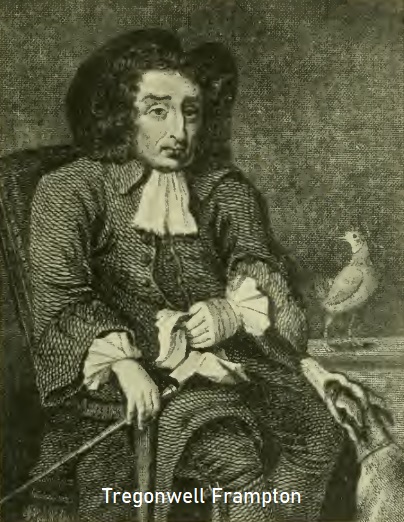
Tregonwell Frampton was born at Moreton in Dorset, the fifth son of the Lord of the Manor of Moreton, William Frampton, and his wife Katharine who came from Milton Abbas. From an early age Tregonwell enjoyed country pursuits, especially hawking, cock-fighting and hare coursing, although throughout his life his main love was reserved for horse racing. He was born at a time when the earliest shoots of racing were beginning to bloom. Newmarket Heath was cleared in 1660 and this, along with Nell Gwynn, attracted King Charles II to Newmarket. Tregonwell began to attend race meetings on a regular basis, even buying a house in Newmarket, and he acquired ground at the foot of Warren Hill and Long Hill on which he built his first stables in 1670. He could rightly be called the first trainer in Newmarket, the ‘father of the turf’, and was made the official ‘keeper of the running horses’ at Newmarket in 1695, initially for William III who died on 8th March 1702, followed by Queen Anne who died on 1st August 1714, then George I who died on 22nd June 1727, and finally George II who outlived Tregonwell. By 1700 it is alleged that he supervised a stable of racehorses in Newmarket, receiving an annual sum of £1000 to pay for ten boys to look after the horses, and for all of the feedstuff and expenses associated with training. It was further rumoured that he received £100 for every horse in training. In 1704 he built a stable block which remains in place today at Heath House and Osborne House Stables. Indeed, Osborne House lays claim to being the oldest stable block in Newmarket. It is currently used to house the yearlings of neighbouring Heath House Stables, and the site mysteriously contains 5 separate wells, now bricked up, but their original purpose is uncertain. He died on 12th March 1727 and is buried in All Saints Church in Newmarket.
For over 4 centuries racing has been staged in Newmarket, but how have the racecourses evolved from an initial starting point at Fleam Dyke Pumping Station, some 8 miles from the town, with a winning post barely 200 metres from the town centre, into two world recognized, excellent racecourses and a universal acceptance that Newmarket is the Headquarters of racing?
To access an interactive racecourse map showing over 50 individually named racecourses CLICK HERE. The map will enable you to:-
1. Determine when extended races over 8 miles, 6 miles and 4 miles began to be replaced by the courses now visited by thousands annually;
2. Consider how the challenge of crossing the Devil's Dyke was overcome;
3. Contemplate why the town no longer has a steeplechase course despite having at least 5 courses during the past 2 centuries;
4. Examine the practicalities of having up to 48 starting posts and winning posts;
5. Appreciate that it was not financially viable to have an open racecourse spread widely across the heath, with a finishing post barely 200 metres from the town centre;
6. Research how and why the Cambridgeshire Handicap has been contested over 3 different courses.
NOTE: The map does not make mention of 2 particular courses:-
(i) Sefton Course (also known as the Cambridge Road Course)
Source: 1970 Raceform. Used from 1959 to 1975.
(ii) New Circular Course
The Circular Handicap was run on Friday 29th October 1875 on the New Circular Course of about two miles.
Source: London Standard (30th October 1875): ''the horses started near the Turn of the Lands, ran back way of the Cambridgeshire Course towards the Ditch, and afterwards proceeded down the side of the Tan Gallop, and turned into the Rowley Mile near the Bretby Stakes starting post, finishing at the stand at the end of the flat. Except in the hollow near the Cambridgeshire start the runners should have been visible all the way if the sky had been bright and clear''.
Another report hoped that the Circular Handicap would become a feature in future programmes, as it would be contested in front of the new grandstand which would be completed in about a year and would be able to accommodate thousands.
(I am grateful to Tim Cox for bringing attention to these 2 courses.)
Enjoy researching the intriguing history of Newmarket and its many racecourses.
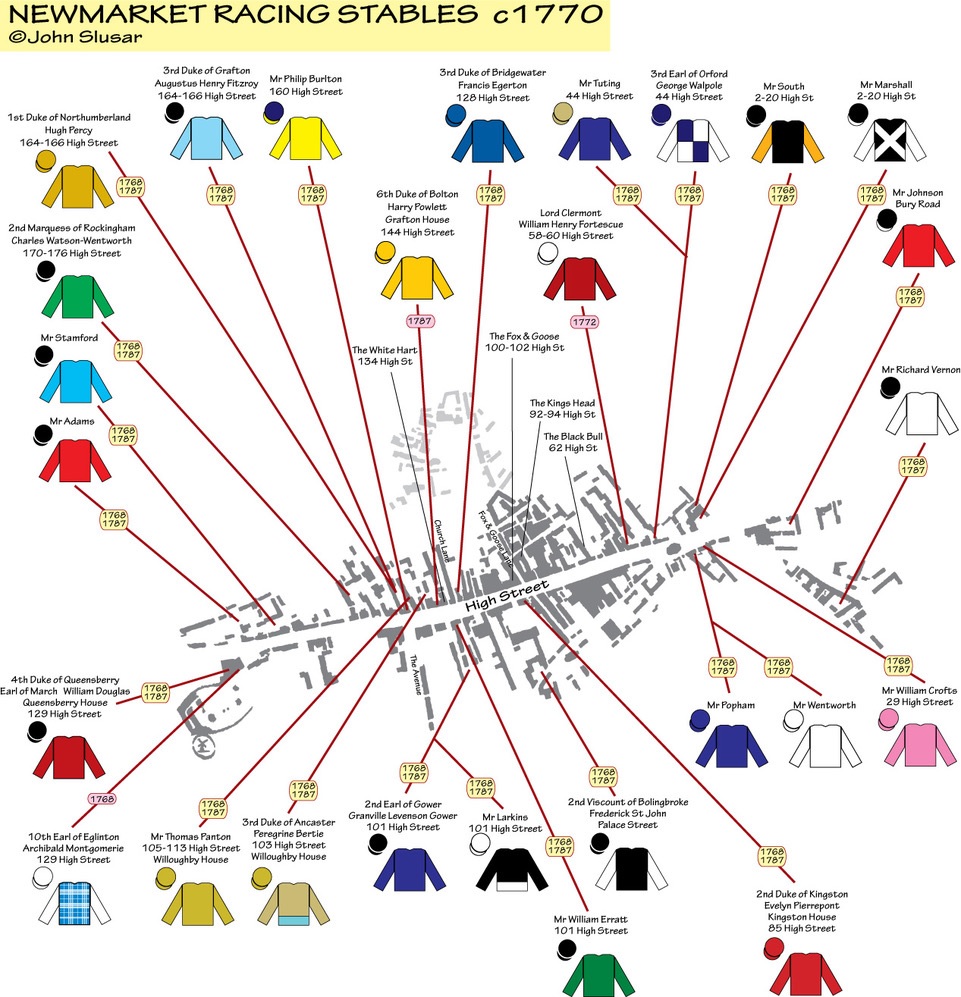
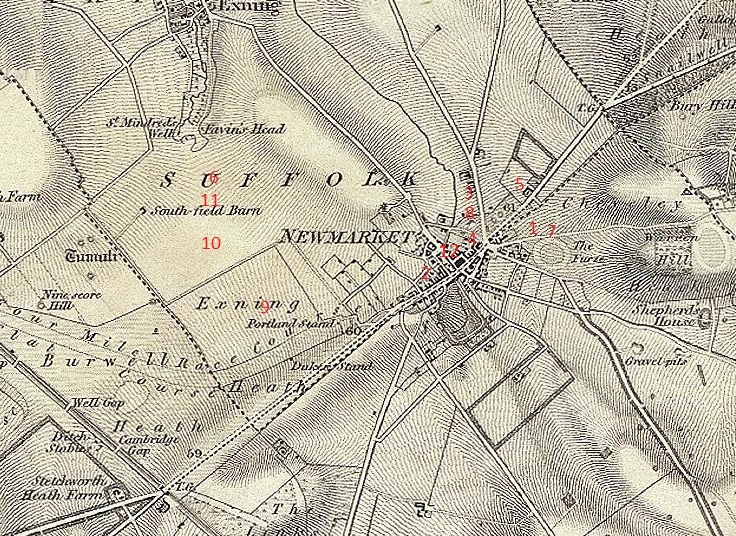
Early 18th century to mid-19th century
After Tregonwell Franpton died his stables were sold to Weatherby's who leased them to a multitude of trainers. Heath House Stables were eventually purchased by Jack Waugh in 1945.
1861-1864 Joseph Dawson
Joseph Dawson, son of racehorse trainer George Dawson and Jean Dawson (nee Alison) was born in 1825, one of 17 children. Father George had trained for Lord Montgomery at Bogside and later for the Earl of Eglinton, and his sons inherited the racing gene, with four of them, Thomas, Mathew, Joseph and John all going on to become trainers. Joseph spent the first part of his career at Middleham before moving on to train at East Ilsley in 1853. In 1861 he was invited to become private trainer for the Earl of Stamford at Heath House Stables, recording an early Classic success with Diophantus (SR 1942) in the 2000 Guineas for the 7th Earl of Stamford. In 1862, supported by the Duke of Portland, he increased the number of boxes at Heath House and, within a year, he had captured his second Classic, the 1863 1000 Guineas with Lady Augusta (SR 1957). In 1864 he fell out of favour with the 7th Earl of Stamford, having to sue him to obtain the money he was owed, but he vacated Heath House in favour of brother Mat.
1861 2000 Guineas DIOPHANTUS 25/1 (SR 1942) owned by 7th Earl of Stamford, trained by Joseph Dawson and ridden by Arthur Edwards
1863 1000 Guineas LADY AUGUSTA 100/30 (SR 1957) owned by 7th Earl of Stamford, trained by Joseph Dawson and ridden by Arthur Edwards
1866-1886 Mathew Dawson, Fred Archer
Mathew Dawson was another of the 17 children of George Dawson and served his training apprenticeship with his father before becoming Head Lad to his brother Thomas at Middleham in 1838. By 1840 he had returned to Scotland where he set up as a trainer in his own right, followed four years later by his marriage to Mary Rose on 8th July 1844. In the early 1850s he moved to Newmarket to train on Church Road, close to St Mary's Church. He worked for James Merry at Russley Park, although following an argument with James he moved back to Newmarket in 1866 to begin the most successful two decades of his career at Heath House Stables. In 1869 he formed an association with Lord Falmouth, managing his stud. In the 1875 Kelly's Directory the principal jockeys listed at Heath House Stables were Fred Archer (6st 10lbs), J Bowman (5st 12lbs) and S Saddington (5st 7lbs). The 1883 Kelly's Directory records Matt Dawson at Heath House, with Thomas Chaloner over the road at Osborne House. Dawson teamed up with Fred Archer, viewed by many as the best jockey ever to grace the turf, and fully nurtured and developed his talents. George Blackwell was Head Lad to Mat Dawson and George Dawson before setting up as a trainer in 1892. Such was Mat Dawson's success that it is impossible to list his many top-class winners, although all of his Classic winners are listed below. Towards the end of the 1885 season Mat gave serious thought to retiring, passing on the reins at Heath House to nephew George in 1886.
1867 Cesarewitch JULIUS 12/1 owned by the Duke of Newcastle, trained by Mat Dawson and ridden by Tom Chaloner
1870 Epsom Derby KINGCRAFT 20/1 (SR 2049) owned by 4th Viscount Falmouth, trained by Mat Dawson and ridden by Tom French
1873 1000 Guineas CECILIA 33/1 (SR 1895) owned by 6th Viscount Falmouth, trained by Mat Dawson and ridden by Jack Morris
1874 2000 Guineas ATLANTIC 10/1 (SR 1996) owned by 6th Viscount Falmouth, trained by Mat Dawson and ridden by Fred Archer
1875 2000 Guineas CAMBALLO 7/2 (SR 2014) owned by Clare Vyner, trained by Mat Dawson and ridden by John Osborne junior
1875 1000 Guineas SPINAWAY 10/1 (SR 1933) owned by 6th Viscount Falmouth, trained by Mat Dawson and ridden by Fred Archer
1875 Epsom Oaks SPINAWAY 5/4 fav (SR 1933) owned by 6th Viscount Falmouth, trained by Mat Dawson and ridden by Fred Archer
1877 Epsom Derby SILVIO 100/9 (SR 1981) owned by 6th Viscount Falmouth, trained by Mat Dawson and ridden by Fred Archer
1877 St Leger SILVIO 6/4 fav (SR 1981) owned by 6th Viscount Falmouth, trained by Mat Dawson and ridden by Fred Archer
1877 Criterion Stakes at Newmarket JANNETTE (Evens fav) owned by 6th Viscount Falmouth, trained by Mat Dawson and ridden by Fred Archer
1878 Epsom Oaks JANNETTE 65/40 fav (SR 1923) owned by 6th Viscount Falmouth, trained by Mat Dawson and ridden by Fred Archer
1878 St Leger JANNETTE 5/2 fav (SR 1923) owned by 6th Viscount Falmouth, trained by Mat Dawson and ridden by Fred Archer
1879 2000 Guineas CHARIBERT 25/1 (SR 1921) owned by 6th Viscount Falmouth, trained by Mat Dawson and ridden by Fred Archer
1879 1000 Guineas WHEEL OF FORTUNE 40/75 fav (SR 2052) owned by 6th Viscount Falmouth, trained by Mat Dawson and ridden by Fred Archer
1879 Epsom Oaks WHEEL OF FORTUNE 1/3 fav (SR 2032) owned by Lord Falmouth, trained by Mat Dawson and ridden by Fred Archer
1882 St Leger DUTCH OVEN 40/1 (SR 1848) owned by 6th Viscount Falmouth, trained by Mat Dawson and ridden by Fred Archer
1883 2000 Guineas GALLIARD 9/2 (SR 1932) owned by 6th Viscount Falmouth, trained by Mat Dawson and ridden by Fred Archer
1884 Ascot Gold Cup ST SIMON 8/15 fav owned by 6th Duke of Portland, trained by Mat Dawson and ridden by Charles Wood
1884 Goodwood Cup ST SIMON 7/100 fav owned by 6th Duke of Portland, trained by Mat Dawson and ridden by Charles Wood
1884 Epsom Gold Cup ST SIMON (walked over) owned by 6th Duke of Portland, trained by Mat Dawson and ridden by Charles Wood
1884 St Leger THE LAMBKIN 9/1 (SR 1861) owned by Robert C Vyner, trained by Mat Dawson and ridden by John Watts
1884 Criterion Stakes at Newmarket MELTON (2/5 fav) owned by 20th Baron Hastings, trained by Mat Dawson and ridden by Fred Archer
1885 Epsom Derby MELTON 75/40 (SR 2047) owned by 20th Baron Hastings, trained by Mat Dawson and ridden by Fred Archer
1885 St Leger MELTON 1/6 fav (SR 2047) owned by 20th Baron Hastings, trained by Mat Dawson and ridden by Fred Archer
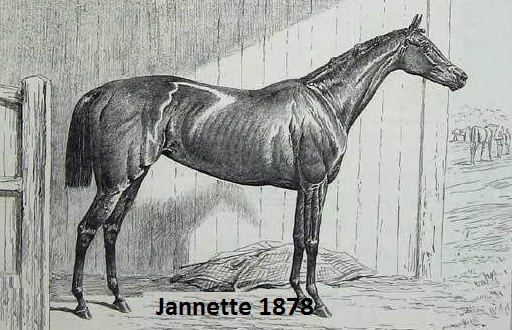
JANNETTE (SR 1923)
The bay mare Jannette (SR 1923), by Lord Clifden out of Chevisaunce, was bred by the 6th Viscount Falmouth, Evelyn Boscawen, and was born in 1875. She was trained by Mat Dawson at Heath House Stables and enjoyed an unbeaten two-year-old career, winning all 7 races which included the Richmond Stakes. Despite her encouraging two-year-old career she was sent off at 25/1 in the 1000 Guineas, being beaten by 3/4 length by 4/5 favourite Pilgrimage. In what was seen as a two-horse race in the Epsom Oaks, Jannette was made 65/40 second favourite behind Pilgrimage (evens fav), but got her revenge by a length. She was made 5/2 favourite for the St Leger and her backers did not have a moments worry as she forged clear by 4 lengths. In a career encompassing 23 races, Jannette was victorious on 17 occasions, and was second in four other races. As a broodmare she did not enjoy the same success she experienced on the racecourse.
MELTON (SR 2047)
The small bay colt Melton (SR 2047), by Master Kildare out of Violet Melrose, was bred by the 20th Baron Hastings, George Manners Astley in 1882 and was trained by Mat Dawson at Heath House Stables. Melton was launched into the deep end in the New Stakes, now called the Norfolk Stakes, at Royal Ascot, achieving a somewhat unexpected victory. He was then defeated in the July Stakes when a win was expected, but in the Middle Park Plate Fred Archer employed waiting tactics and duly won at 10/1. Although Melton did not contest the 2000 Guineas, preferring an easier introduction in the Payne Stakes at Newmarket, before winning the Epsom Derby at 75/40 favourite by a head from Paradox. Strongly fancied for the St Leger, he was made the 1/6 favourite and duly obliged by 6 lengths. In a career spanning 18 races, Melton won 11 and was second on 3 other occasions.
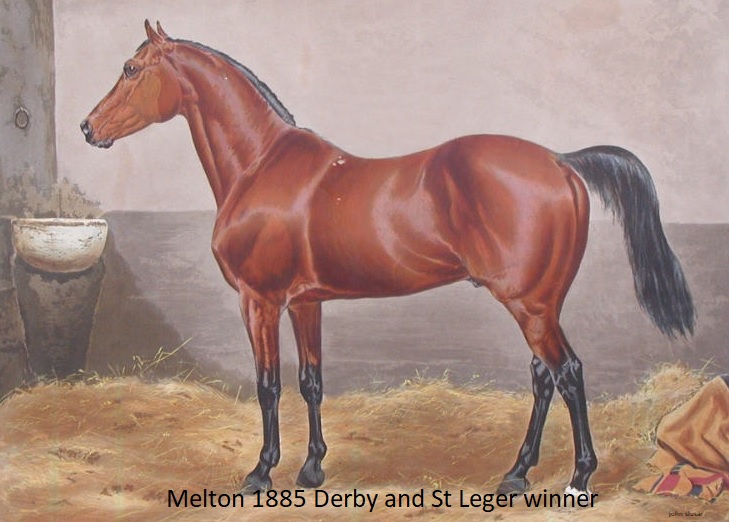
1883-April 1886 Tom Chaloner
Tom Chaloner, son of Thomas and Mary Chaloner, was born on 2nd June 1839 in Manchester. When he was 13 years of age he moved, along with his brothers Willie and Dick, to Ashgill Stables, Yorkshire, where he was apprentice to trainer John Osborne. Tom had his first ride at Carlisle on Thursday 7th July 1853, where Bridesmaid carried 6st 7lbs, although Tom weighed just 4st 7lbs at the time, and the pair came last of 4. He had to wait a further 2 years before he claimed his first win at Liverpool on Thursday 12th July 1855 in a Liverpool Sweepstake aboard Sister to Mrs Rigby (4/7 fav) for owner Mr E Buckley. Whilst at Ashgill Stables he fell in love with John Osborne's sister, Ellen, and the pair married in Spring 1865 at Leyburn, Yorkshire. The couple went on to have 8 children, Thomas (born 1866), George (born 1869), Mary Ellen (born 1872), Richard (born 1873), Philip (born 1875), Harry (born 1876), John, and William. Tom was an extremely successful jockey, winning 10 English Classics. He won the 1861 St Leger aboard Caller Ou (SR 1892); the 1862 Epsom Oaks aboard Fille de Joie (SR 1949), the 1862 St Leger aboard The Marquis (SR 1920), the 1863 2000 Guineas and Epsom Derby aboard Macaroni (SR 2017), the 1867 St Leger aboard Achievement (SR 2008), the 1868 2000 Guineas when dead-heating aboard Moslem (SR 1965), the 1868 St Leger aboard Formosa (SR 2076), the 1873 2000 Guineas aboard Gang Forward (SR 1962) and the 1875 St Leger aboard Craigmillar (SR 1985). At the end of his riding career Tom launched his new career as a trainer at Osborne House, ably supported by his wife, Ellen, and their sons, many of whom were successful jockeys. The highlight of his short training career was winning the 1884 2000 Guineas with Scot Free (SR 1949) for owner Mr James Foy when ridden by Billy Platt. Tom died after a long illness at Osborne House on Saturday 3rd April 1886 aged just 46. He left a personal estate of £799 1s 6d, the equivalent in 2020 to £105,000.
1883 Sapling Plate at Sandown SCOT FREE owned by Mr James Foy, trained by Tom Chaloner and ridden by John Osborne
1884 Craven Stakes SCOT FREE 6/1 owned by Mr James Foy, trained by Tom Chaloner and ridden by John Osborne
1884 2000 Guineas SCOT FREE (SR 1949) 3/1 owned by Mr James Joy, trained by Tom Chaloner and ridden by Billy Platt
1866-1937 Tom O Chaloner
Tom O Chaloner, born in 1866, was the oldest son of Tom and Ellen, and trained at Middleham and Newmarket. When Tom senior died at the young age of 46 in 1886 his mother Ellen, just 43 at the time and with 8 children to raise, took over at Osborne House, successfully applying for a trainer's licence, although it appears Tom junior had to be the registered trainer. Indeed, one of the controversial winners trained at Osborne House was his first winner as a trainer, Jacob, who won 2 races on consecutive days at Hampton Court racecourse in 1886. He later went on to train at Stockbridge House, training Marco to win the 1895 Cambridgeshire for owner Mr F Luscombe. Tom died aged 72 on Monday 29th November 1937
1886 Manor Plate at Hampton JACOB 5/2 owned by Mrs T Chaloner, trained by Tom O Chaloner and ridden by Jimmy Woodburn
1886 Surrey & Middlesex Handicap Stakes at Hampton JACOB 7/4 owned by Mrs T Chaloner, trained by Tom O Chaloner and ridden by George Chaloner
1895 Cambridgeshire MARCO 9/1 owned by Mr F Luscombe, trained by Tom O Chaloner and ridden by Fred Allsopp
1869-1935 George Chaloner
George Chaloner was born on 9th November 1869 in Middleham, Yorkshire, son of Ellen and Tom Chaloner, who had ridden the 1863 Derby winner Macaroni (SR 2017), and George followed in his father's footsteps and became a successful jockey, winning the 1888 Royal Hunt Cup aboard Shilelagh, and again in 1892 with Suspender. He also won the 1891 Wokingham Stakes on Rathbeal. After retiring as a jockey, he tried his hand at training, especially for Captain Machell at Machell Place. By 1896 his weight had caught up with him and, backed by Captain Machell who had been associated with many of his winners, he set up as a trainer in the autumn, being granted a Newmarket licence in September 1896. Initially he leased Park Lodge from Lord Stanley, but Machell installed him at Chetwynd House. Captain Machell's fortunes improved in the 1899 season despite have so few horses at Machell Place, where George Chaloner also trained for Bunny Leigh. In 1901 George Chaloner trained Stealaway to land the Royal Hunt Cup for Bunny Leigh at 4/1. Captain Machell's health continued to deteriorate, and he died on Sunday 11th May 1902, and was buried in Newmarket cemetery on Saturday 17th May 1902. George Chaloner continued to train at Machell Place and was listed as the main trainer in July 1906 by the Sporting Life when they listed all trainers around the country. In May 1908 he was ordered to take a complete rest by his doctor for fear of a nervous breakdown, while on Wednesday 30th December 1908 he married Hannah Hyner, of Newmarket, at St Catharine's Church, Ventnor, spending their honeymoon in Norwich. He retired from training in 1910 and became a farmer in Bedford, dying on Wednesday 18th December 1935.
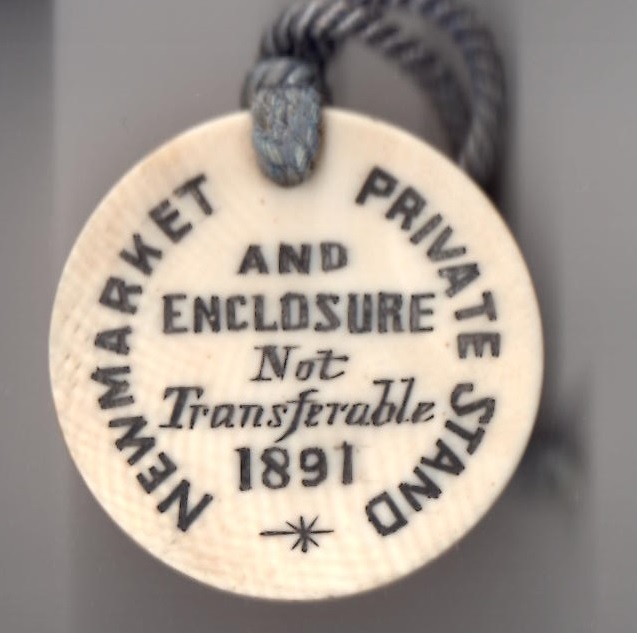
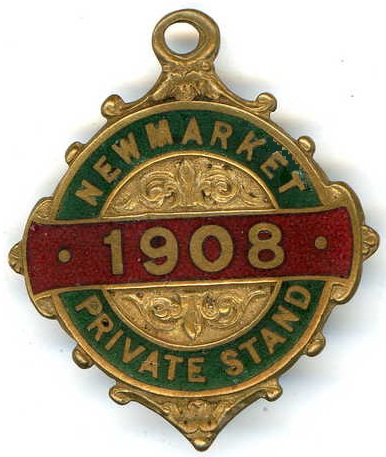
1873-1936 Richard (Dick) Chaloner
Richard (Dick) Chaloner, fourth son of Tom and Ellen, was born in Middleham on 29th October 1873 and followed in his famous father's footsteps to become a jockey. He won the 1890 Great Metropolitan Handicap at Epsom aboard Parlington, repeating the win the next year when partnering the Duke of Beaufort's Ragimunde at 4/1. Later that year Richard rode Ragimunde to win the Cesarewitch at 25/1 for the Duke when trained by Alec Taylor. Increasing weight led to him shifting his attention to training and he supported his mother Ellen at Osborne House, following his brother Tom once Tom had moved on to take charge at Stockbridge House. In 1896 the Links Plate at Newmarket became a real family affair when Richard trained and rode the winner, Grand National, for owner Mr J Carr, defeating into third place his brother Philip, who was having his first ride in public on Jessie Soden. Richard continued to train at Osborne House after the turn of the century, guiding Joe Chamberlain to success in the 1900 Northumberland Plate, and was joined in 1907 by brother Philip, but moved on in 1908 when Philip took full charge, training privately for Mr J C Dyer. Unfortunately, Philip died unexpectedly in April 1910. Richard continued to train, but died in Newmarket on Sunday 15th November 1936 aged 63.
1896 Links Plate at Newmarket GRAND NATIONAL 8/11 fav owned by Mr J Carr, ridden and trained by Richard Chaloner
1900 Friday Welter Handicap at Newmarket JOE CHAMBERLAIN 7/4 owned by Mr J C Dyer, trained by Richard Chaloner and ridden by Tod Sloan
1900 Newmarket Handicap JOE CHAMBERLAIN 11/8 owned by Mr J C Dyer, trained by Richard Chaloner and ridden by Tod Sloan
1900 Northumberland Plate JOE CHAMBERLAIN 8/1 owned by Mr J C Dyer, trained by Richard Chaloner and ridden by J H (Skeets) Martin
1875-April 1910 Philip Arrowsmith Chaloner
Philip Arrowsmith Chaloner, fifth son of Tom and Ellen, was born in 1875 and had his first ride in public aboard Jessie Soden when third in the Links Plate at Newmarket in December 1896. He was a good lightweight jockey until increasing weight put paid to his riding career. He then turned his hand to training, assuming joint control, with his elder brother Richard, at Osborne House Stables in 1907. In 1908 he took full control, acting as private trainer to Mr T C Dyer at Osborne House. During his brief time as a trainer he took charge of Joe Chamberlain, who had already won the 1900 Northumberland Plate as a 3-year-old, and was also responsible for Fiscal War, Fiscal Fighter, Tariff Reformer and Mauve Patch. He was taken ill in the middle of April 1910 and died of pleurisy and pneumonia on Tuesday 19th April 1910.
1876 Harry Chaloner
Harry Chaloner, born on 7th August 1876, was the son of Tom and Ellen, and younger brother of Tom, George, Richard and Philip. He was apprentice to Matthew Dawson at Heath House Stables, Newmarket, and would have been influenced by Fred Archer who was riding in the same stable. Harry rode his first winner aboard Prince Francis (10/1) for Matthew Dawson in the Apprentices Plate at Newmarket on Tuesday 18th April 1893. In August 1896 he relocated to Germany to ride for Baron Oppenheim, and later trained in Australia.
September 1919-January 1922 Walter Sanderson
Walter Sanderson, born at Hambleton in 1879, was the eldest son of William Sanderson who trained variously in Yorkshire for many years. After riding as an apprentice at Kingsclere, Walter Sanderson was appointed private trainer to Mr J W Larnach at Red House. The stables were taken at the end of 1902 for a year and he trained his first winner at Manchester in September 1903. Mr Larnach, from an Australian banking family, built new stables, Lanwades House, and Sanderson moved there from Red House in April 1909. He was rejected by the Army in April 1918 on health grounds, but left Lanwades House in September 1919, taking over Osborne House stables where he trained publicly for 3 years. In January 1922, with 13 horses, he left Newmarket for the north, setting up again at Bellevue, Doncaster, where he rented a few boxes from Doncaster Corporation in a modern complex used by several trainers.
January 1923--1924 Hugh Powney
Hugh Powney was destined to become a racehorse trainer, for his father taught him the art of reading pedigree lines from an early age. His father, John, lived his entire life in the same house at Lansdown, Bath, being born and dying in the exact same room in May 1894. He owned racehorses for over 50 years, and is widely, but incorrectly, reported to have owned the staying horse The Hero, when he won the 1847 Goodwood Cup. However, the Racing Calendars and all newspapers at that time record John Day as the owner, with John Powney not owning him until the horse was 6-years-old. As a 3-year-old, the chestnut colt The Hero ran in the colours of John Day when second at 4/1 favourite in the Goodwood Stakes behind Jonathan Wild on Wednesday 29th July 1846. On Friday 14th August 1846 The Hero won 2 consecutive races for John Day at Salisbury, winning the Salisbury Handicap from Miss Shirley when ridden by A Day, and then walking over in the Salisbury Gold Cup over 2 miles. He won the Dundas Stakes, His Majesty's Plate and the County Cup at York in August. He opened his 4-year-old account at Ascot Heath on Thursday 3rd June 1847 wearing the colours of John Day in His Majesty The Emperor of Russia's Plate, beating Wolf-dog when 6/4 joint favourite. However, the pinnacle of his career was reached on Thursday 29th July 1847, still in the ownership of John Day, when The Hero won the Goodwood Cup (4/5 fav) over 2 3/4 miles from Eryx. As a 5-year-old in 1848 he won again at Goodwood for John Day, but he was bought by John Powney in 1849 as a six-year-old and ran down the field in 6th behind Lord Stanley's Canezou in the Goodwood Cup on Thursday 2nd August 1849.
Hugh assisted his brother John at Grateley before going on to assist Major Bewick. He then was appointed private trainer to Sir Ernest Cassel at Moulton Paddocks, although Sir Ernest died on 21st September 1921. Hugh then became a public trainer at Waterwich House, Newmarket, while in January 1923 he occupied a few boxes at Osborne House, leased from Ellen Chaloner. He then re-launched his training career at Grateley, Hamblton where he continued to train for a number of years until, in November 1933, he was appointed private trainer to Mr Michalinos at Jevington, Sussex. In 1935 Hugh Powney purchased Savile House for £5,000, training there until the outbreak of the Second World War when it was seconded by the Ministry of Food for use as a storage premises. Hugh used the time away from training as a stud manager and also acted as Clerk of the Scales. It was during his time at Savile House that he trained Sandsprite (100/1), owned by Mrs Florence Nagle and ridden by J Crouch, to finish second in the 1937 Epsom Derby behind Mididay Sun (100/7). Hugh died in his sleep in March 1945, aged 69, at Durrington, near Salisbury, where he was on business.
1925-1927 Alec Waugh
Alec Waugh, son of Richard Waugh who trained in Germany for the Kaiser, and nephew to Dawson and Tom Waugh, trained a string of 40 horses in Germany before the First World War, but once the War broke out he was interned at Ruhleben. At the end of the War Alec returned to Newmarket and in the 1925 season he trained 8 jumpers at Osborne House. The horses included Mr Reg Day's Mentagne, Mr Dawson Waugh's Malpas and Lt-Colonel Leake's Starosta. He returned to Germany in the 1930s, but was back training in England by the mid-1940s at Marlborough House.
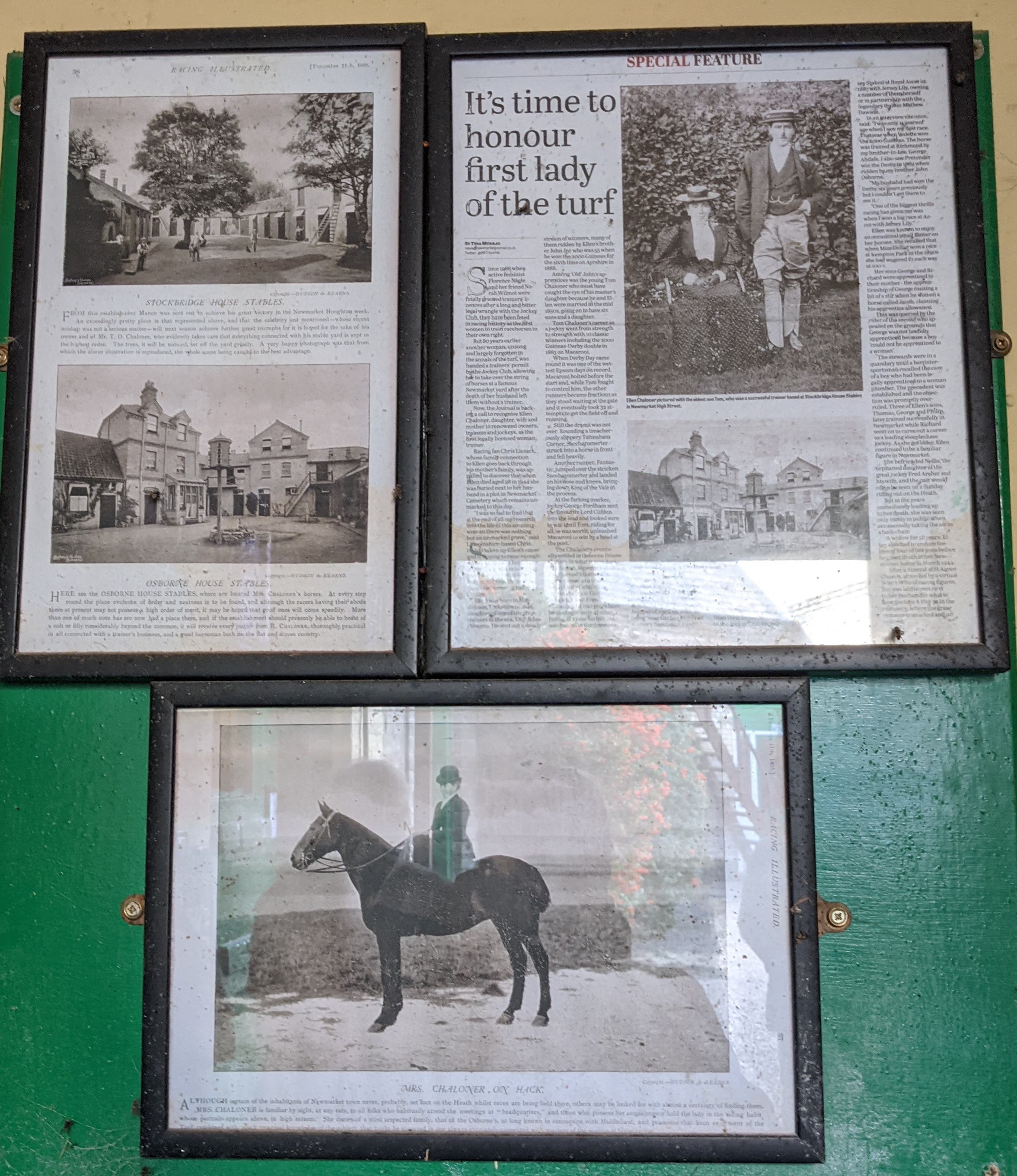
April 1886-March 1944 Ellen Chaloner
Ellen Chaloner (nee Osborne) was the sister of John Osborne, 12-time English Classic winning jockey, including the 1869 Epsom Derby on Pretender (SR 2018) and the 1874 Epsom Oaks on Apology (SR 2001). Ellen fondly recalled that she attended Newmarket races in April 1857, aged just 11, to witness her brother John Osborne win the 2000 Guineas on Vedette (SR 1963) for the 2nd Earl of Zetland. She was born on 27th December 1845 and spent her early life in Yorkshire, and was often seen around her brother's yard at Ashgill where she met Tom Chaloner; the couple married in Spring 1865. They moved to Newmarket and, when Tom retired as a jockey in 1883 he embarked on a new career as a trainer at Osborne House. Tom died at the young age of 46 in 1886, leaving Ellen to manage a stable and fend for 8 children, the oldest Thomas was just 20. Ellen had to fight the racing authorities to take over her husband's training license, for at that time women were not allowed to train under their own name. Her application was successful and she began training at Osborne House in April 1886, although all newspaper records show that the licence was held in son Tom's name. Her appointment was not without controversy, and was not widely accepted. Her son George, born in 1869, became an apprentice at the stable in 1886, and there was a rumour spread that when he won a race at Hampton Court aboard Jacob in 1886 an objection was raised by the jockey of the second horse, Charles Wood, citing that George could not be a lawful apprentice because a boy could not be apprenticed to a woman. The rumour further stated that her barrister found a case where a boy plumber was apprentice to a woman, and used the argument to successfully defend Ellen and get the objection overruled. However, there is no mention of this in newspapers at the time, and the actual result of the race suggests it might only have been a popular rumour at the time. The races in question concerned a horse owned by Ellen Chaloner named Jacob, which contested the Manor Plate at Hampton racecourse in 1886, winning it by 8 lengths in the hands of Jimmy Woodburn at 5/2, although the sporting papers list Tom Chaloner junior as the trainer.
The next day Jacob turned out for the Surrey and Middlesex Handicap Stakes against a sole opponent, Sir George Chetwynd's Giesshubler, the 40/85 favourite ridden by Charles Wood. This time Jacob was ridden by apprentice George Chaloner and, once again, trained by Tom Chaloner. Jacob won by an easy 3 lengths, but Charles Wood failed to draw the weight and his mount was disqualified. It is worth mentioning that one of the Stewards at that meeting was Sir George Chetwynd, along with Lord Londesborough, Earl of Sefton, Lord Rendlesham, Earl Foulett, Lord M Beresford and Sir F Johnstone. As a postscript to this incident, in January 1964 Miss Nora Wilmot and Mrs Florence Nagle were continuing to battle with the Jockey Club to be the first women to be granted a trainer's licence to train in their own right, having failed each time they had previously made an application. Norah and Florence were eventually granted their licence in 1966, Norah sending out her first winner, Pat, at Brighton in August 1966. Ellen was struck by a number of tragedies in her life, not least her husband dying in 1886, but she also lost her daughter, Mary Ellen, on Saturday 5th September 1896 aged 24, after just 2 days of illness. On Tuesday 28th December 1937 the Reverend William Colville-Wallis, former vicar of St Agnes Church, Exning, died in his sleep at Osborne House aged 84 whilst staying with Ellen Chaloner. She recalled that he did not retire until he was 82, and that he was well-known to racing personalities, although he did not bet.
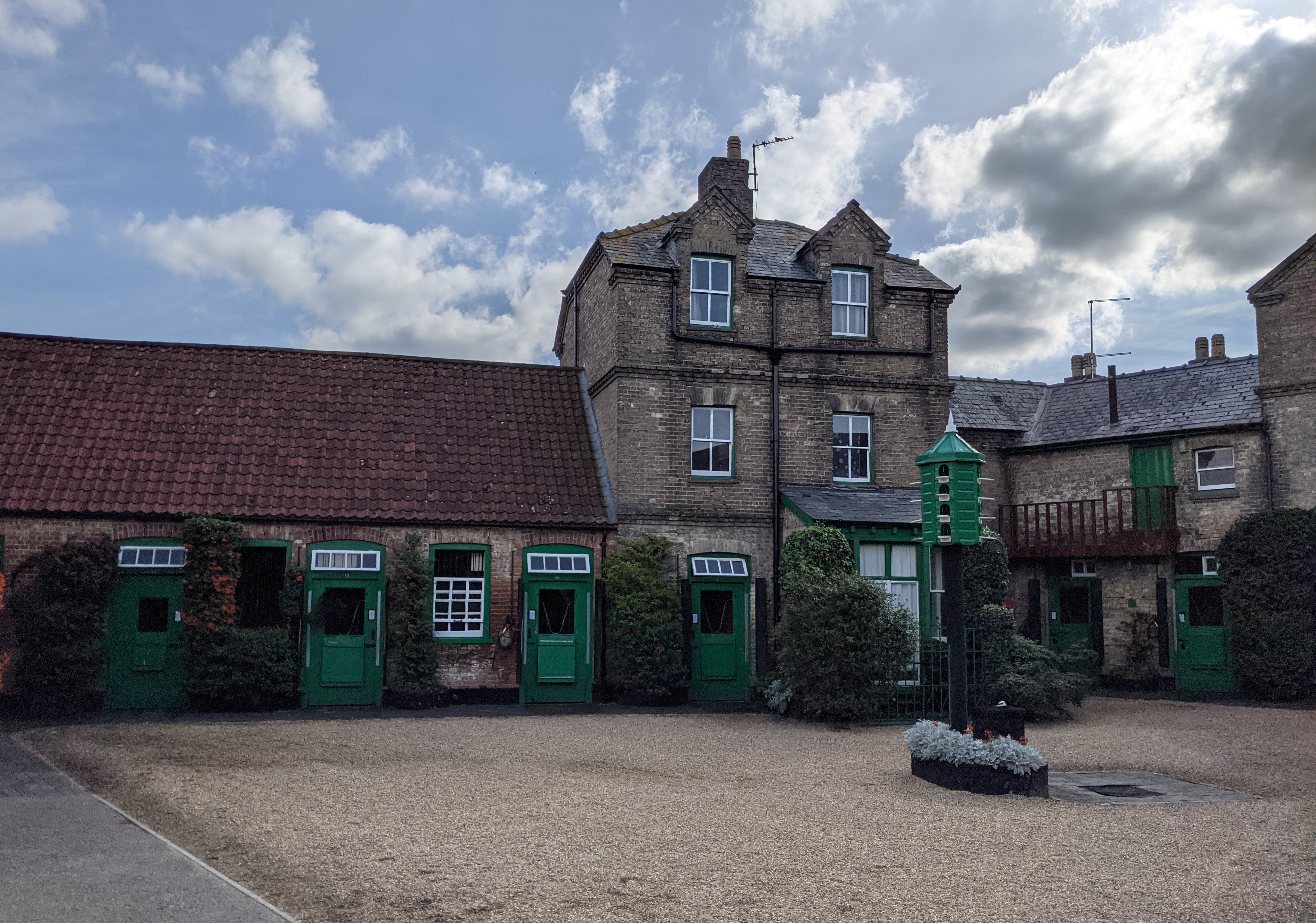
November 1946-1948 Richard A Emery
Richard A Emery trained at Balsham, near Cambridge up to November 1946, but on 12th November he successfully applied for a licence to train in Newmarket. On Wednesday 13th November 1946 he transferred his string of 10 horses to Osborne House, where he remained for the next 3 years. He won many low class races at Midlands tracks, including Leicester and Lincoln, even venturing as far north as Redcar occasionally. In 1949 he relocated to Cheveley where he continued his training career.
April 1947 Fillies Plate at Leicester ANGELUS BELL 20/1 trained by Richard Emery and ridden by Tommy Lowrey
June 1948 Stakes race at Redcar GOLDEN MICKEY 100/30 trained by Richard Emery and ridden by P Maher
1949-1970 Jack Waugh
Jack Alfred James Waugh was born on 11th November 1911, eldest son of the Classic winning racehorse trainer Tom Waugh who won the 1920 1000 Guineas with Cinna (SR 1958). Jack was Head Lad to his father from 1927 until 1932, moving on to take up the post of Assistant Trainer to Basil Jarvis from 1932 to 1939. He served with the Royal Artillery during World War II, but was wounded at Dieppe in 1942 and invalided out. He took over the yard of his uncle, Dawson Waugh, in 1943, winning with Response at Newmarket in April 1943. In 1945 he purchased Heath House Stables, remaining for the next quarter of a century. He also later purchased Osborne House Stables, just across the road from Heath House, increasing his capacity to 50 boxes and simultaneously acquiring boxes 12-19 which are thought to be the oldest surviving boxes in Newmarket. Although he did not train a Classic winner, Arabian Night (33/1) finished second in the 1954 Epsom Derby behind Never Say Die (SR 2124), beaten just 2 lengths. In 1957 he won the Coventry Stakes for Lord Howard de Walden with Amerigo. Arguably his best chance of winning the Derby was in 1964 when Oncidium was made 9/2 second favourite, but he was comfortably beaten by Santa Claus (SR 2073). In 1956 he saddled Matador to win the July Cup at Newmarket and the Goodwood Stewards Cup, while a decade later he saddled Lucasland to land the July Cup and the Diadem Stakes. In 1962 George Duffield became an apprentice at Heath House, while in 1965 Sir Mark Prescott became Jack Waugh's Assistant Trainer. Sir Mark took out a provisional licence in 1969 when Jack became seriously ill, taking full control in 1970 when Jack Waugh retired as a trainer, but Jack continued his association with racing, managing Egerton Stud for Sir Reginald Macdonald-Buchanan, and standing in as a Steward at Headquarters when the need arose. He died in September 1999 aged 87.
1956 July Cup MATADOR 11/2 owned by Mrs J Ferguson, trained by Jack Waugh and ridden by Bill Rickaby
1956 Stewards Cup MATADOR 100/8 owned by Mrs J Ferguson, trained by Jack Waugh and ridden by Eph Smith
1957 Coventry Stakes AMERIGO 7/4 fav owned by Lord Howard de Walden, trained by Jack Waugh and ridden by Eph Smith
1962 Princess Elizabeth Stakes ALMIRANTA 10/1 owned by Lord Howard de Walden, trained by Jack Waugh and ridden by Joe Sime
1962 Park Hill Stakes ALMIRANTA 7/2 owned by Lord Howard de Walden, trained by Jack Waugh and ridden by Harry Carr
1963 Ribblesdale Stakes OSTRYA 100/9 owned by Lord Howard de Walden, trained by Jack Waugh and ridden by Jimmy Lindley
1966 July Cup LUCASLAND 100/6 owned by John Baillie, trained by Jack Waugh and ridden by Eric Eldin
1966 Diadem Stakes LUCASLAND 7/2 owned by Lord Howard de Walden, trained by Jack Waugh and ridden by Eric Eldin
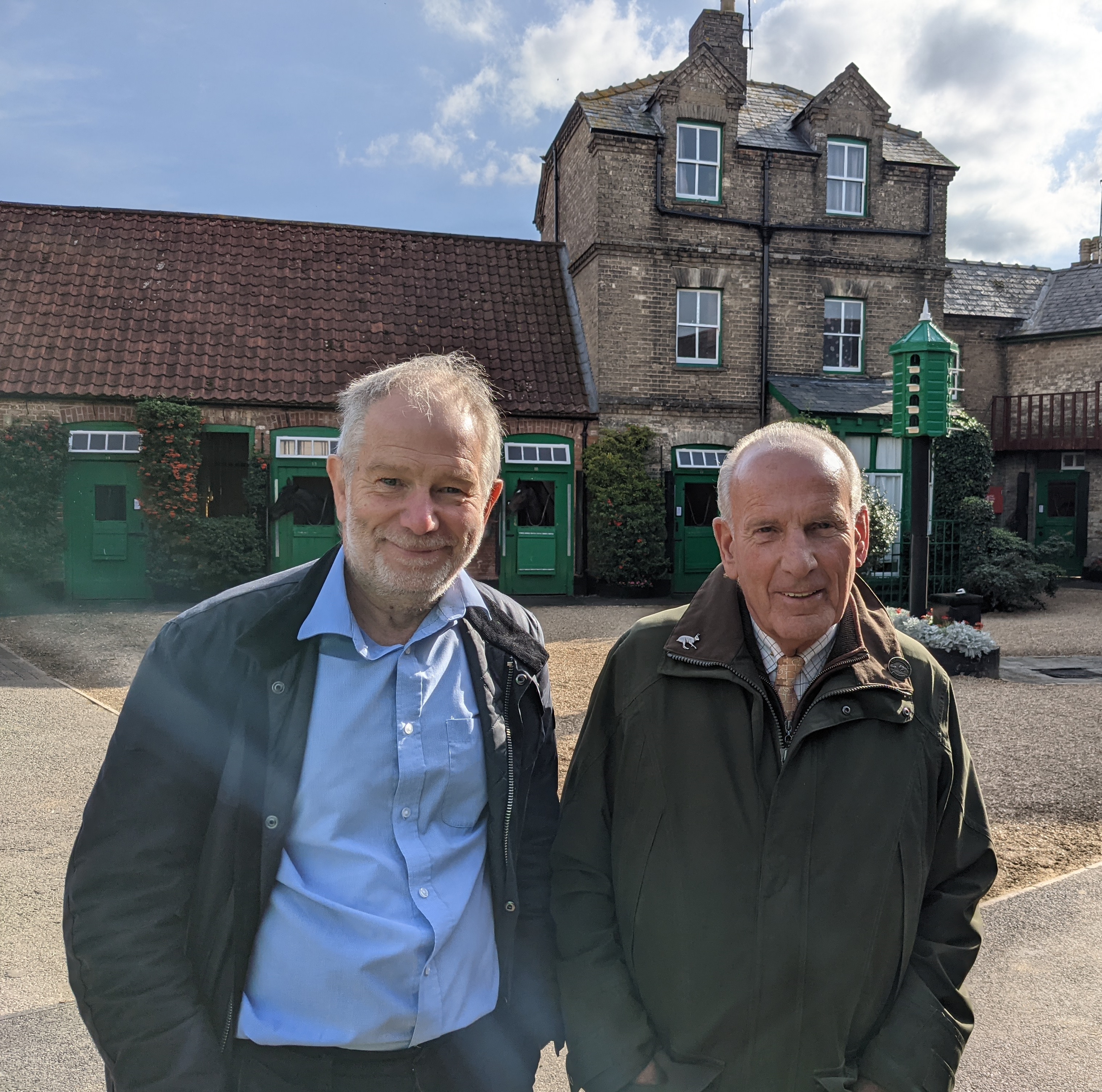
1970 to the present Sir Mark Prescott
Sir Mark Prescott, 3rd Baronet, a title which he inherited from his uncle, was born on 3rd March 1948 the son of a theatre and art critic. He was educated at Harrow School, but aged 17 he broke his back in a riding accident and was hospitalised in Oswestry for 9 months. Sir Mark took on the role of Assistant Trainer to Jack Waugh at Heath House in 1965, taking out his own provisional trainer's licence in 1969 when Jack Waugh became seriously ill. He took full charge at Heath House in 1970 on the retirement from training of Jack Waugh, and has excelled as a trainer ever since. In 1972 Sir Mark appointed Colin Nutter to be Head Lad, a partnership which remains intact to this day. Also, in 1972 he assigned Booths the task of building him new wooden boxes. He is widely regarded as one of the most professional trainers in Newmarket, commanding loyalty and respect from all of his staff. As well as the deep bond with Colin Nutter, Sir Mark has remained loyal to a small, select group of jockeys, notably George Duffield and Seb Sanders, and more recently Luke Morris. In 1980 Sir Mark placed his two-year-old Spindrifter to win 13 races in a single season, equalling the all-time record for a juvenile. Furthermore, between the years 1981 to 1985 he trained the mare Misty Halo to win exactly 50% of her 42 races, which remains a post-War record for a mare. More recently he has won the 1996 King's Stand Stakes at Ascot and Nunthorpe Stakes at York with Pivotal, repeating his Nunthorpe success as recently as 2017 with Marsha. Sir Mark fully embraces his role as the custodian of one of the oldest, best respected training establishments in Newmarket.
Sir Mark Prescott
1980 Places SPINDRIFTER to win 13 races in a juvenile season
1988 Cambridgeshire QUINLAN TERRY 11/1 trained by Sir Mark Prescott and ridden by George Duffield
1994 Ebor Handicap HASTEN TO ADD 13/2 fav trained by Sir Mark Prescott and ridden by George Duffield
1996 King’s Stand Stakes PIVOTAL owned by Cheveley Park Stud, trained by Sir Mark Prescott and ridden by George Duffield
1966 Nassau Stakes LAST SECOND owned by Faisal bin Salman, trained by Sir Mark Prescott and ridden by George Duffield
1996 Nunthorpe Stakes PIVOTAL owned by Cheveley Park Stud, trained by Sir Mark Prescott and ridden by George Duffield
1997 John Smith's Magnet Cup PASTERNAK 13/2 owned by Graham Rock, trained by Sir Mark Prescott and ridden by George Duffield
1997 Cambridgeshire PASTERNAK 4/1 fav owned by Graham Rock, trained by Sir Mark Prescott and ridden by George Duffield
1998 Champion Stakes ALBORADA owned by Kirsten Rausing, trained by Sir Mark Prescott and ridden by George Duffield
1998 Nassau Stakes ALBORADA owned by Kirsten Rausing, trained by Sir Mark Prescott and ridden by George Duffield
1999 Champion Stakes ALBORADA owned by Kirsten Rausing, trained by Sir Mark Prescott and ridden by George Duffield
2001 John Smith's Magnet Cup FOREIGN AFFAIRS 5/2 fav trained by Sir Mark Prescott and ridden by George Duffield
2003 Cambridgeshire CHIVALRY 14/1 trained by Sir Mark Prescott and ridden by George Duffield
2010 Cheveley Park Stakes HOORAY owned by Cheveley Park Stud, trained by Sir Mark Prescott and ridden by Seb Sanders
2017 Nunthorpe Stakes MARSHA owned by Elite Racing Club, trained by Sir Mark Prescott and ridden by Luke Morris
ST SIMON (1884 Ascot Gold Cup, Goodwood Cup, Epsom Gold Cup)
WHEEL OF FORTUNE (1879 Epsom Oaks, 1000 Guineas)
KINGCRAFT (1870 Epsom Derby)
MELTON (1885 Epsom Derby, St Leger)
CAMBALLO (1875 2000 Guineas)



